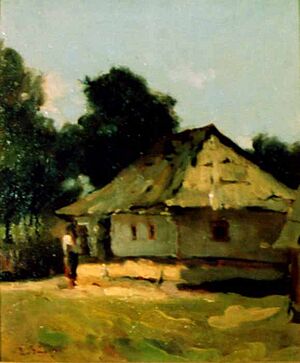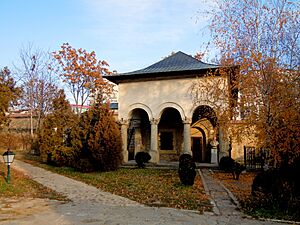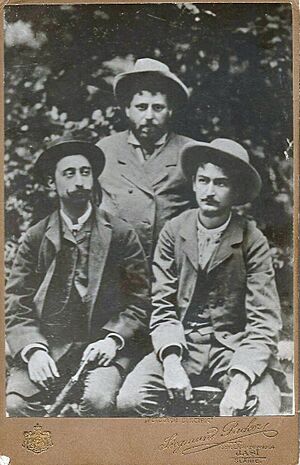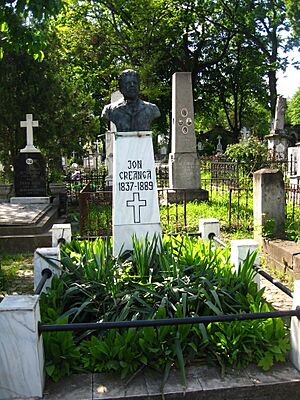Ion Creangă facts for kids
Quick facts for kids
Ion Torcălău Ioan Ștefănescu |
|
|---|---|
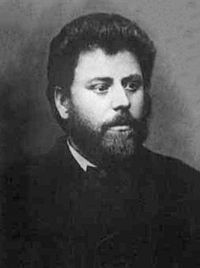 |
|
| Born | March 1, 1837 Humulești, Principality of Moldavia (now part of Târgu Neamț, Romania |
| Died | December 31, 1889 (aged 52) (seizure) Iași, Kingdom of Romania |
| Resting place | Eternitatea Cemetery, Iași, Romania |
| Pen name | Popa Smântână, Ioan Vântură-Țară |
| Occupation | Writer, educator, deacon |
| Language | Romanian |
| Nationality |
|
| Period | 1864–1883 |
| Genre | anecdote, children's literature, fable, fairy tale, fantasy, lyric poetry, memoir, novella, satire, short story, sketch story |
| Literary movement | Realism, Junimea |
| Spouse | Ileana Grigoriu (December 26, 1859 - 1873) |
| Children | Constantin (December 19, 1860) |
| Signature | |
 |
|
Ion Creangă (also known as Nică al lui Ștefan a Petrei; March 1, 1837 – December 31, 1889) was a famous Romanian writer, schoolteacher, and deacon. He is one of the most important figures in 19th-century Romanian literature.
Creangă is best known for his book Childhood Memories. He also wrote many novellas, short stories, and funny anecdotes. His stories often mix fantasy and children's literature. They feature main characters like "Harap Alb" and "Ivan Turbincă". He also wrote popular fairy tales such as "The Story of the Pig" and "The Goat and Her Three Kids".
His writings are seen as masterpieces of the Romanian language. They are also known for their local humor. Creangă's works combine old folk stories with his own creative ideas. He brought a realistic style inspired by rural life to Romanian literature.
Ion Creangă was an innovative educator and wrote textbooks. He was also friends with Romania's national poet Mihai Eminescu. Both were part of the important literary group Junimea. Creangă helped share the group's cultural ideas in an easy-to-understand way. Today, he is considered one of the greatest Junimist writers, alongside Eminescu, Ion Luca Caragiale, and Ioan Slavici.
After his death, Ion Creangă received many honors. Several places in Romania and Moldova are named after him. These include the Bojdeuca building in Iași. This house became Romania's first memorial house in 1918.
Contents
Ion Creangă's Life Story
Early Life and Family
Ion Creangă was born in Humulești in the Principality of Moldavia. This village is now part of Târgu Neamț city. His father, Ștefan sin Petre Ciubotariul, was a wool trader. His mother, Smaranda, came from a family of community leaders.
The area where he grew up was near the Carpathian Mountains. People there lived a traditional life, focused on shepherding and making textiles. This region was also known for its old local folklore. Creangă's family was important in their community. His mother wanted him to become a priest.
Ion Creangă was likely born on March 1, 1837. At that time, people were often known by nicknames. He was called Nică, a short form of Ion. He was also known as Nică al lui Ștefan a Petrei, meaning "Nică of Ștefan of Petru".
Childhood and Education
Ion Creangă's early childhood was very happy. He later wrote about it in his Childhood Memories. He started primary school, which was run by the Orthodox Church. He was known for being a bit rebellious and sometimes skipping school.
He learned to read and write using the Romanian Cyrillic alphabet. Later, he was sent to a school in Broșteni. After some time, he returned home and worked in wool-spinning. This earned him the nickname Torcălău ("Spinster").
Around four years later, he went back to school in Târgu Neamț. In 1854, he joined the Fălticeni seminary. There, he started using his mother's family name, Creangă. In August 1855, he moved to the Central Seminary in Iași.
In 1858, his father died, and Creangă needed to support himself. He married Ileana Grigoriu, the 15-year-old daughter of a priest, in August 1859. He became a cantor at his father-in-law's church. In December of the same year, he was ordained as a deacon.
Becoming a Schoolteacher
In 1860, Creangă started studying at the Faculty of Theology in Iași. His son, Constantin, was born in December 1860. In 1864, he attended the Trei Ierarhi Monastery normal school. There, he met Titu Maiorescu, who was his teacher. Creangă graduated as the top student in his class in June 1865.
Creangă was very passionate about improving education. He supported Maiorescu's ideas for education reform. He especially liked new ways of teaching reading and writing. He became a teacher at Trisfetite and was known for being strict.
He also helped write a new primer called Metodă nouă de scriere și cetire. It was published in 1868. This book helped students learn the new Romanian alphabet, which replaced the old Cyrillic one. It became a very popular textbook. He also wrote a poem called Păsărica în timpul iernii ("The Little Bird in Wintertime"). In 1871, he published another book, Învățătoriul copiilor ("The Children's Teacher"). This book included fables and a sketch story called "Human Stupidity".
Around 1867, his wife Ileana left him. After this, Creangă became less interested in his church duties.
Creangă also became interested in politics. He joined a nationalist group called the Free and Independent Faction. He was known by the nickname Popa Smântână ("Priest Sour Cream"). He was even a candidate for a seat in the Romanian Deputies' Chamber in Iași.
His independent attitude caused some issues with church leaders. He was temporarily suspended from his church duties. He then decided to leave the clergy and started wearing regular clothes. This caused some public discussion at the time.
Life in Bojdeuca
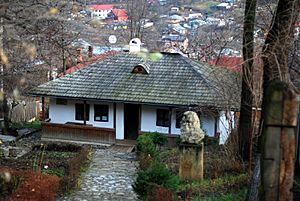
In 1872, Creangă moved into a small house on the edge of Iași. He called it Bojdeuca, which means "tiny hut" in the Moldavian dialect. He lived there with Ecaterina "Tinca" Vartic. She was a laundress who had rented a room in the house. They lived a simple, peasant-like life.
In May 1874, his friend Maiorescu, who was then the Minister of Education, helped Creangă get a teaching job again. He became a schoolteacher in the Păcurari area of Iași.
Around this time, in the summer of 1875, Ion Creangă met Mihai Eminescu. Eminescu was working as a school inspector. They quickly became best friends. Eminescu was fascinated by Creangă's talent for telling stories. Creangă, in turn, admired Eminescu's knowledge.
Becoming a Famous Writer
Autumn 1875 is when Ion Creangă truly began his writing career. His first short story, "The Mother with Three Daughters-in-Law", was published in October. It appeared in Convorbiri Literare, the magazine of the Junimea literary club. It is believed that Eminescu encouraged him to start writing down his stories.
Convorbiri Literare published 15 of Creangă's fiction works. It also published the four parts of his Childhood Memories. His storytelling talent amazed his new colleagues. They even had a psychologist, Eduard Gruber, study how Creangă created his stories. Creangă often discussed his ideas with Tinca Vartic, who was his first audience.
In 1876, Creangă also published an educational book called Povățuitoriu la cetire prin scriere după sistema fonetică. This book was meant to be a standard textbook for training teachers.
Mihai Eminescu often stayed at Bojdeuca after losing his job as a school inspector. He was looked after by Creangă and Tinca. Eminescu even lived in the house for five months. During this time, he wrote many of his poems. Creangă introduced Eminescu to his friends, who shared his simple lifestyle and nationalist views.
By 1877, Eminescu had moved to Bucharest. Creangă often wrote to him, asking him to return. In 1879, Creangă bought the Bojdeuca house in Tinca Vartic's name. That same year, he and his colleagues published Geografia județului Iași ("The Geography of Iași County"). In 1880, he published another educational book, Regulile limbei române ("Rules of the Romanian Language").
Later Years and Passing
By the 1880s, Creangă began to suffer from epilepsy. His health declined, and he became very heavy.
Despite his illness, he stayed informed about cultural and political discussions in Romania. He also hosted Eminescu sometimes, witnessing his friend's struggles with mental disorder. Their friendship became more distant over time.
In 1887, Creangă lost his teaching job. He traveled to Bucharest to ask for his pension rights. He hoped his friend Maiorescu would help him, but he was disappointed. In his last years, he joined a different literary group.
Among Creangă's last works was the fourth and final part of his Memories, written around 1888. He also left a story unfinished, called Făt-frumos, fiul iepei ("Făt-Frumos, Son of the Mare").
Ion Creangă passed away on December 31, 1889, after an epileptic seizure. He was buried in Iași's Eternitatea Cemetery. Many intellectuals from Iași attended his funeral.
Ion Creangă's Famous Works
Popular Tales
Ion Creangă's stories are a mix of old folk tales and his own unique storytelling style. He collected and changed narratives from his home region. This made them his original contributions to short story, fantasy, and children's literature.
"The Goat and Her Three Kids" is a fable about a mother goat's love. In the story, a wolf tricks his way into the goat's house. He eats two of the disobedient kids. The youngest kid, however, hides in the chimney and escapes.
"The Story of the Pig" shows how parental love can overcome anything. An old peasant couple adopts a piglet. They don't know he is enchanted. The piglet is very smart and makes his parents happy. He builds a magical bridge and marries the emperor's daughter. Then, he reveals he is a Făt-Frumos, or Prince Charming, who only shows his true form at night.
"The Old Man's Daughter and the Old Woman's Daughter" has a similar theme. It is like the story of Cinderella. However, Creangă sets it in a rural village, which gives it a unique feel.
Stories with a Twist
Many of Creangă's stories use themes from Christian mythology. He often shows God, Saint Peter, and even devils acting like regular people. This is usually done in a funny way. A key story in this group is "Dănilă Prepeleac".
Another story is "Ivan Turbincă". The main character, a Russian soldier, challenges both Heaven and Hell. He eventually manages to trick Death. This story uses themes from both Romanian and Ukrainian folklore. The character of Ivan Turbincă is similar to German tradition's Till Eulenspiegel.
"Harap Alb" is one of Creangă's most complex stories. Its main message is that a talented person will gain respect, no matter how they appear.
Childhood Memories
Childhood Memories is one of Creangă's most famous books. It tells the story of his own childhood. It is written like a traditional oral story. The narrator often speaks directly to the reader.
The book is not like a diary. Instead, it is a symbolic story about "the childhood of the universal child." It captures the typical experiences of growing up in a village.
Educational Writings
Creangă also wrote many didactic fables. These are stories that teach a lesson. They are often written as lively dialogues.
One example is "The Needle and the Sledge Hammer". In this story, tools used for metalworking scold their creations. They tell them not to forget where they came from. Another similar story is "The Flax and the Shirt". It shows how plants become cloth and then get recycled. The lesson is that "all things are not what they seem."
Other stories in this group include:
- Pâcală: A story that focuses on dialogue.
- "The Bear Tricked by the Fox": A funny story that explains why bears have short tails.
- Cinci pâini ("Five Loafs of Bread"): A story that teaches against greed.
"Human Stupidity" is a fable about extreme foolishness. A peasant tries to find people dumber than his wife. She panicked because a ball of salt might fall and hurt their baby. This story highlights how illogical behavior can be found in everyday life.
"The Story of a Lazy Man" is another fable. The main character is so lazy that he finds chewing food too much effort. His fellow villagers decide to get rid of him. A noblewoman tries to help him by offering soft bread crumbs. But he asks, "But are your bread crumbs soft?" This shows his extreme laziness, even in the face of danger.
Images for kids
See also
 In Spanish: Ion Creangă para niños
In Spanish: Ion Creangă para niños


